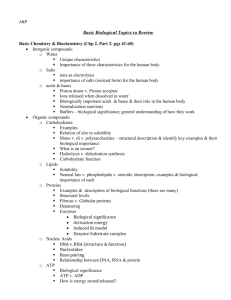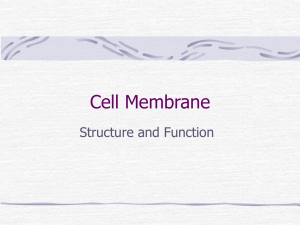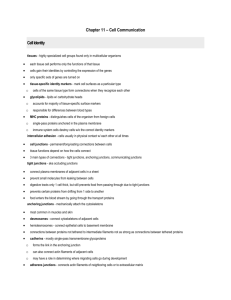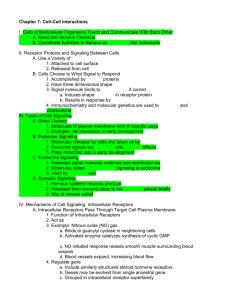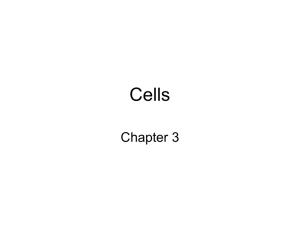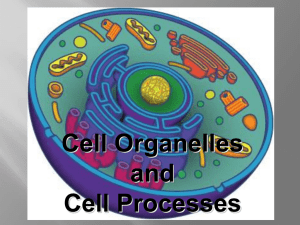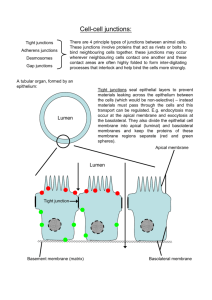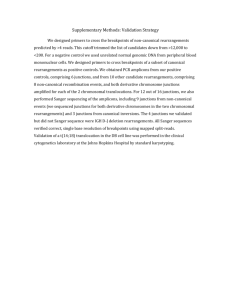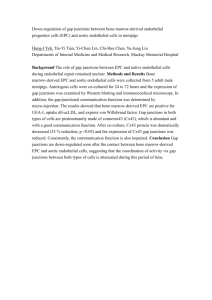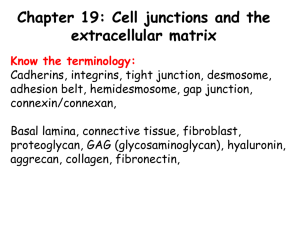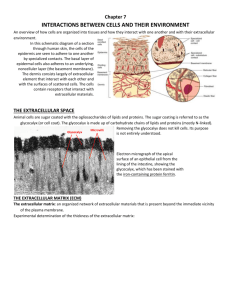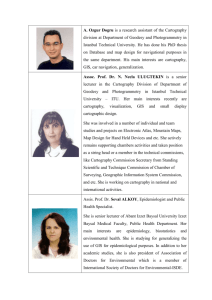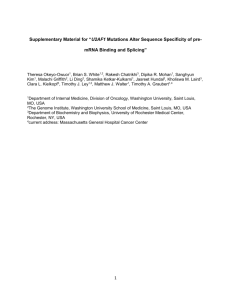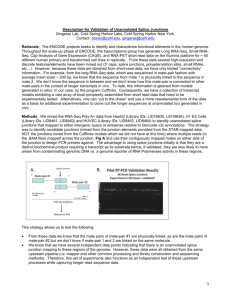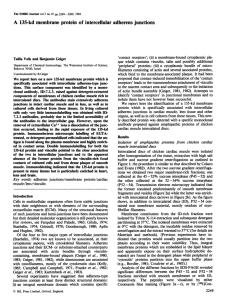File
advertisement
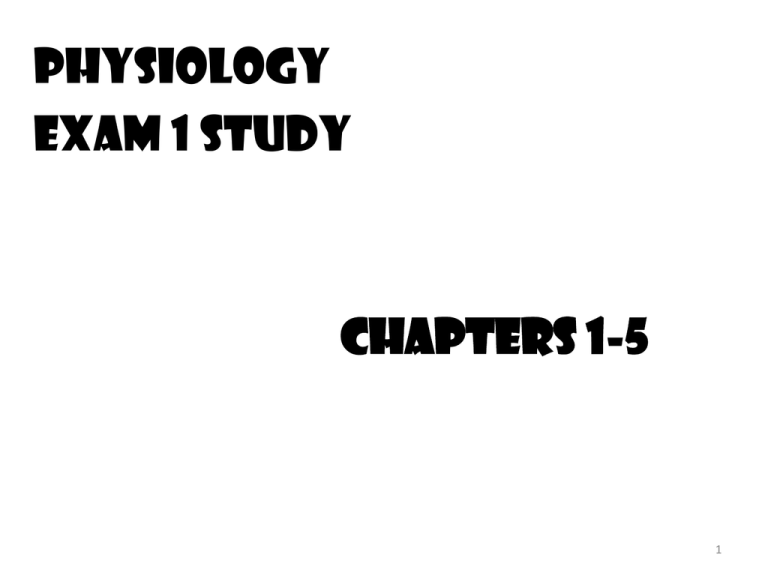
Physiology Exam 1 Study chapters 1-5 1 The cytoplasm includes all material inside the cell membrane except for_____. 2 Nucleus 3 Which elements make up 90% of your body’s mass? 4 Carbon Hydrogen Oxygen 5 The alpha helix and pleated sheets are examples of ____ structure proteins. 6 Secondary 7 A sequence of amino acids are examples of ____ structure proteins. 8 Primary 9 Fibrous proteins (Collagen) and Globular proteins (Hemoglobin) are examples of ____ structure proteins. 10 Quaternary structure 11 A 5M solution of 0.100 mL glucose contains how many grams of glucose? (m.w. of glucose is 180g) 12 M = #mols of solute L of solution 90g glucose 13 Name the six nonmembraneous organelles 14 Cilia Centrioles Microvilli Cytoskeleton Flagella Ribosomes 15 How many primary tissue types are in the human body? 16 Four 17 What are the primary tissue types in the body? 18 Epithelial Connective Muscle Neural 19 Plasma is to blood as ____ is to cytoplasm. 20 Cytosol 21 Clathrin and Caveolae are used in which process by the cell to bring molecules in to the cytoplasm? 22 Endocytosis 23 How does potocytosis differ from endocytosis? 24 Potocytosis uses caveolae rather than clathrin coated pits to bring molecules into the cell. 25 What happens to macromolecules that are too large to enter or leave cells through protein channels or carriers? 26 Cells use two basic mechanisms to import large molecules and particles: phogocytosis and endocytosis. 27 In osmosis water always moves towards the ___ solution, that is the solution with the ___ concentration of solute. 28 Hypertonic, Higher 29 During osmosis, what happens to water once all concentrations are equal? 30 Net movement of water stops. 31 What are the units of osmotic pressure? 32 atmospheres (atm) or millimeters of mercury (mm Hg) 33 If a cell is place in solution A and it swells, solution A is ____. 34 Hypotonic 35 If a cell is place in solution B and it shrinks, solution B is ____. 36 Hypertonic 37 If a cell is place in solution C and it doesn’t change size, solution C is ____. 38 Isotonic 39 The framework of cilia, flagella, centriole, and mitotic spindle is formed by ____. 40 Microtubels 41 What cellular specialization causes fluid to flow over the epithelial surface? 42 Cilia 43 What is the main component of cytosol? 44 Water 45 What layer of skin protects from bacterial, chemical, and mechanical injuries? 46 Epidermis 47 What layer of skin contains adipose tissue? 48 Hypodermis 49 What is the movement of molecules across the cell membrane with the aid of a membrane protein? 50 Facilitated diffusion 51 Where are receptors molecules for chemical signaling located? 52 Cell Membrane Cytoplasm Nucleus 53 What is a bond in which atoms are completely lost or gained during bonding? 54 Ionic Bond 55 What is a molecule whose shared electrons are distributed so evenly that there are no regions of partial charge? 56 Non-polar molecules 57 What is an antioxidant? 58 A molecule that alters free radicals 59 What would we expect from a cell with an extensive Golgi Apparatus? 60 Secretion of a lot of material 61 What would we expect from a cell with a large number of Mitochondria? 62 Production of large amounts of energy (ATP). 63 You conduct a study on 20 18 year olds (subjects) to see how intensity of exercise influence heart rate. What is the dependent variable? 64 Heart rate 65 You conduct a study on 20 18 year olds (subjects) to see how intensity of exercise influence heart rate. What is the independent variable? 66 Intensity of exercise 67 What is a bond that results when two atoms share a pair of electrons, one from each atom? 68 Covalent bond 69 Of the following bonds; hydrogen, covalent, and Van der Waals Forces, which bond usually requires input of energy to be broken? 70 Covalent bonds 71 The cells of any tissue are held together by specialized connections called_____. 72 Cell Junctions 73 _____ junctions create cytoplasmic communication bridges between adjoining cells so that chemical and electrical signaling pass rapidly from one cell to the next. 74 Gap Junctions 75 What cell junction are occluding. 76 Tight junctions 77 Which type of junctions create what is called the blood-brain barrier? 78 Tight junctions 79 Which type use Cadherin proteins? 80 Desmosomes (anchoring junctions) 81 Which type of junctions Connexin proteins? 82 Gap junctions 83 What is protein specificity? 84 The ability of a protein to bind to a specific ligand or group of closely related molecules. 85 True or False? One function of a membrane protein is to produce energy. 86 False 87 Cytoplasmic protein fibers come in three sizes. Which is the largest? 88 Microtubles 89 Cytoplasmic protein come in three sizes. Which is the smallest? 90 Micro filaments 91 Cytoplasmic protein come in three sizes. Which is the mid-size? 92 Intermediate filaments 93 What is a molecule that binds to another molecule? 94 Ligand 95 What is a ligand that binds to enzymes and membrane transporters. 96 Substrates 97 The internal skeleton of a cell is composed of what? 98 Micro filaments Microtubels Intermidiate filaments 99 How do proteins and other substances get from the endoplasmic reticulum to the Golgi Apparatus? 100 Vesicles 101 In the cell what are the sacs that digest things called? 102 Lysosomes 103 Where in the cell are lipids manufactured? 104 Smooth ER 105 What is a major difference of active transport and facilitated diffusion? 106 Facilitated diffusion does not require ATP 107 True of False? One function of the cytoskeleton is to maintain a critical size limit on the cell. 108 False 109 What is it called when a group of carrier proteins operate at its maximum rate? 110 Saturation 111 Name the two ways the selectivity of a channel is determined. 112 Diameter of its central pore Electrical Charge of the amino acids that line the channel 113 This type of channel spends most of its time in a closed state? 114 Gated channels 115 This type of channel allows ions to move back and forth across the membrane without regulation and is sometimes called “leak channels or pores?” 116 Open Channels 117

